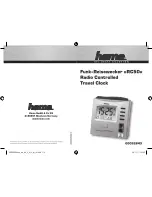
Company Confidential
7
Raveon Technologies Corp.
Any RF-7800W that is a TXRX may be either a PRIMARY or a SECONDARY. Primary
transmitters use TDMA slot 1 to transmit their GPS location in, and Secondary
transmitters use TDMA slot 2 to transmit their GPS locations in.
The second parameter of the MODE command is either a P or S for Primary or
Secondary. For example, to program a secondary transceiver, use the following
command:
MODE TXRX S
3.2. 10/100Base-T
– TCP/IP Socket Connections
The
RF-7800W
user interface is provided via a 10/100Base-T Ethernet interface. All user
communications in and out of the unit use TCP/IP socket connections that are compatible
with Telnet client applications. By default, the RF-7800W is a TCP/IP Telnet server.
The
RF-7800W
can interact with up to five (3) Telnet connections
(“sessions”) at any
given time
– additional connection requests beyond this limit shall be rejected (terminated
and closed) by the
RF-7800W
. By default, all connection attempts require successful
completion of a login authentication challenge sequence before an interactive session will
be established.
The “Primary IP” address that the RF-7800Wis configured to use is set
with the
IPADD
xxx.xxx.xxx.xxx
command.
There are three levels of radio modem access
or session “roles” with corresponding
privileges and features; they are:
“ADMIN”, “USER”, and “DATA”. Three programmable
User Name and Password
(“credentials”) combinations are maintained within the
RF-
7800W
, including one for each of the three roles defined above
.
The default credential
settings and their associated roles are as shown in the following table:
Default
Login Name
Default
Password
Default (fixed)
Role
admin
admin
ADMIN
user
user
USER
data
data
DATA
The following table shows an example session combination used to communicate with
user client applications:
Session #
Port
Port Designator
Role
Session Mode
1
23
PORT1
ADMIN
Command
2
23
PORT4
USER
Command
3
23
PORT5
DATA
Communication








































